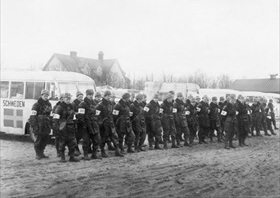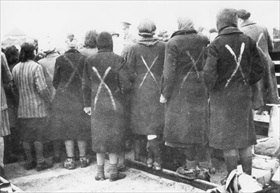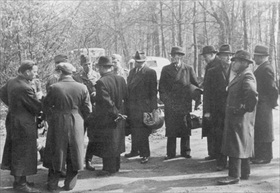PLEA TO RESCUE POWS IN GERMANY
Stockholm, Sweden · February 5, 1945
Within five months from the start of the German conquest of Norway in April 1940 the first Norwegian political prisoners were deported to Germany. Two years later, in September 1943, the first deportations of Danish prisoners and Jews to Germany began after German civil and military authorities assumed direct administration of the country. (Prior to August 29, 1943, the Danish government, parliament, and court system had functioned within the framework of a so-called “German protectorate.”) As the number of Scandinavian prisoners increased, various groups organized relief work for them. The Norwegian seamen’s priests, for instance, visited prisoners in Germany, brought them food, and brought back letters to their families in Norway and Denmark. Other Scandinavians, like the Norwegian civilian internees at Gross Kreutz castle outside Berlin, compiled extensive lists of prisoners and their location and sent the lists to the Swedish embassy in Berlin. (Sweden was a neutral nation during the war.) The Swedish embassy in turn sent the lists to London and the International Red Cross headquarters in Geneva, Switzerland. On this date in 1945 Niels Christian Ditleff, a Norwegian refugee in Sweden, approached the Swedish government about organizing an expedition to rescue concentration camp inmates in the ever-shrinking areas under Nazi control and transport them to Sweden. Heading up the effort was the vice-president of the Swedish Red Cross, Count Folke Bernadotte. Although initially targeted at saving Norwegian and Danish POWs, the “White Buses” program—known for its buses painted entirely white except for either the Red Cross emblem or the flags of either nation on the sides and roof—rapidly expanded to include citizens of other countries. By May 1, 1945—essentially the end of the war—some 15,000 prisoners had been rescued from German camps; of these 8,000 were Scandinavian and 7,000 non-Scandinavian (French, Polish, Czech, British, American, etc.). Among the Scandinavians were 423 Danish Jews rescued from the Theresienstadt concentration camp inside German-occupied Czechoslovakia (today’s Czech Republic). The White Buses program proved to be one of the most extraordinary humanitarian efforts of the war and one of the least known.
[amazon_carousel widget_type=”ASINList” width=”600″ height=”200″ title=”Recommended Reading” market_place=”US” shuffle_products=”False” show_border=”False” asin=”1611450632,1602399689,0374529922,0060580984,1846031176,1848325223,0415426510,9652293970,0553807560,1932033920″ /]
Swedish Red Cross and Danish Government “White Buses” Program in Spring 1945
 |  |
Left: In early April 1945 the Danish Red Cross was able to muster 33 buses, 14 ambulances, 7 trucks, and 4 private vehicles to transport prisoners to freedom.
![]()
Right: Swedish Red Cross buses and drivers transported prisoners from, among other camps, Neuengamme near Hamburg, Sachsenhausen and Ravensbrueck north of Berlin, Dachau north of Munich, Mauthausen east of Linz (Austria), and Theresienstadt, near the Czech city of Terezín.
 |  |
Left: Chalk marks on the backs of female prisoners in the Ravensbrueck concentration camp show that they have been selected for transport by the Swedish Red Cross buses. The only major Nazi concentration camp for women, Ravensbrueck was located in northern Germany, a little more than 50 miles north of Berlin.
![]()
Right: Gestapo officers “escorted” the Red Cross transports. German authorities demanded that every second vehicle have a German officer on board.
Women Inmates at Ravensbrueck Concentration Camp
![]()

 History buffs, there is good news! The Daily Chronicles of World War II is now available as an ebook for $4.99 on Amazon.com. Containing a year’s worth of dated entries from this website, the ebook brings the story of this tumultuous era to life in a compelling, authoritative, and succinct manner. Featuring inventive navigation aids, the ebook enables readers to instantly move forward or backward by month and date to different dated entries. Simple and elegant! Click
History buffs, there is good news! The Daily Chronicles of World War II is now available as an ebook for $4.99 on Amazon.com. Containing a year’s worth of dated entries from this website, the ebook brings the story of this tumultuous era to life in a compelling, authoritative, and succinct manner. Featuring inventive navigation aids, the ebook enables readers to instantly move forward or backward by month and date to different dated entries. Simple and elegant! Click 











